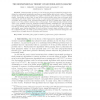108
Voted
MFCS
2004
Springer
15 years 6 months ago
2004
Springer
It was proved by [Garey and Johnson, 1983] that computing the crossing number of a graph is an NP-hard problem. Their reduction, however, used parallel edges and vertices of very h...
97
Voted
MFCS
2004
Springer
15 years 6 months ago
2004
Springer
We study constructive and resource-bounded scaled dimension as an information content measure and obtain several results that parallel previous work on unscaled dimension. Scaled ...
MFCS
2004
Springer
15 years 6 months ago
2004
Springer
How hard is it to invert NP-problems? We show that all superlinearly certified inverses of NP problems are coNP-hard. To do so, we develop a novel proof technique that builds dia...
MFCS
2004
Springer
15 years 6 months ago
2004
Springer
In learning theory and genetic programming, OBDDs are used to represent approximations of Boolean functions. This motivates the investigation of the OBDD complexity of approximatin...
MFCS
2004
Springer
15 years 6 months ago
2004
Springer
We consider infinite antagonistic games over finite graphs. We present conditions that, whenever satisfied by the payoff mapping, assure for both players positional (memoryless...
MFCS
2004
Springer
15 years 6 months ago
2004
Springer
Abstract. In this work, we consider an interesting variant of the wellstudied KP model [18] for selfish routing that reflects some influence from the much older Wardrop model [3...
115
click to vote
MFCS
2004
Springer
15 years 6 months ago
2004
Springer
We study the problem of optimal preemptive scheduling with respect to a general target function. Given n jobs with associated weights and m ≤ n uniformly related machines, one a...
MFCS
2004
Springer
15 years 6 months ago
2004
Springer
We consider the decidability of existence of solutions to language equations involving the operations of shuffle and deletion along trajectories. These operations generalize the o...
127
Voted
MFCS
2004
Springer
15 years 6 months ago
2004
Springer
Abstract. Bidimensionality provides a tool for developing subexponential fixed-parameter algorithms for combinatorial optimization problems on graph families that exclude a minor....
MFCS
2004
Springer
15 years 6 months ago
2004
Springer
Abstract. We devise an efficient protocol by which a series of twoperson games Gi with unique winning strategies can be combined into a single game G with unique winning strategy, ...



